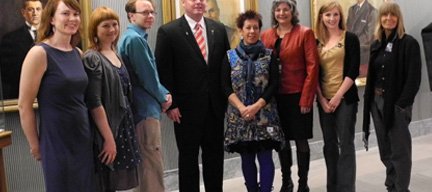Artists part of celebrating 100-year old Legislative Building

Related Programs
This year, Saskatchewan artist Laura Hale has been hired to creatively engage others in celebrating the 100th anniversary of the Saskatchewan Legislature Building.
Through this new artist-in-residence opportunity, people will have the opportunity to learn more about Saskatchewan’s historic Legislative building, as well as more about the artists and artistic legacy that marks the occasion. Hale, who has held other residencies in the province, as well as being the first Culture Days Animateur in 2010, will serve as artist coordinator, overseeing the work of eight other residences with different guest artists that will ultimately result in one legacy artwork for display.
This new artist-in-residence program delivered in partnership by the Saskatchewan Ministry of Parks, Culture and Sport, the Provincial Capital Commission and the Saskatchewan Arts Board, as part of the Creative Partnerships Program, which receives funding assistance from SaskCulture and Saskatchewan Lotteries Trust Fund for Sport, Culture and Recreation.
The artist in residence program at the Saskatchewan Legislature is one of nearly 20 artist residencies currently underway in the province, and one of hundreds held over the years thanks to the innovative Creative Partnerships Innovations and Explorations programs, supported collaboratively by the Saskatchewan Arts Board and SaskCulture.
“The success of partnerships like this come from the fact that in Saskatchewan we have always accomplished great things by working together and sharing resources and expertise,” says Carol Greyeyes, arts consultant, Saskatchewan Arts Board.
“In the past, the artist-in-residence program was a way to get artists into rural communities where access to the arts was almost non-existent, but it began to stimulate a real curiosity about what these artists were doing,” she says. Since those early days, the program, now known as part of the Creative Partnerships Program, has grown to include residencies in schools, businesses, municipalities, First Nations reserves other institutions such as the Synchotron in Saskatoon or the Esterhazy Potash mine.
“What really happens in a residency is transformation,” explains Greyeyes. “The professional artist who has the training in any discipline works collaboratively to engage the community in innovative artistic activity, creating opportunities that might not normally exist. It should work on multiple levels. It should introduce people who have no experience to the art form. It should also help advance the practice of those in the community who already have some basic skills and knowledge. And finally, it should be a collaboration and mentorship between individuals and the senior artist.”
The writer-in-residence writing therapy project that involved Saskatchewan writer Ted Dyck and the Canadian Mental Health Association (Saskatchewan Division) is another great example. “Since the inception of the pilot project in 2009, the project has continued to find great success in using writing to provide therapeutic support for mental health clients,” says Greyeyes. “The successful Explorations Writing for Therapy Project andWriting for Your Life Project have produced an impressive showcase of talented writers in Saskatchewan.”




